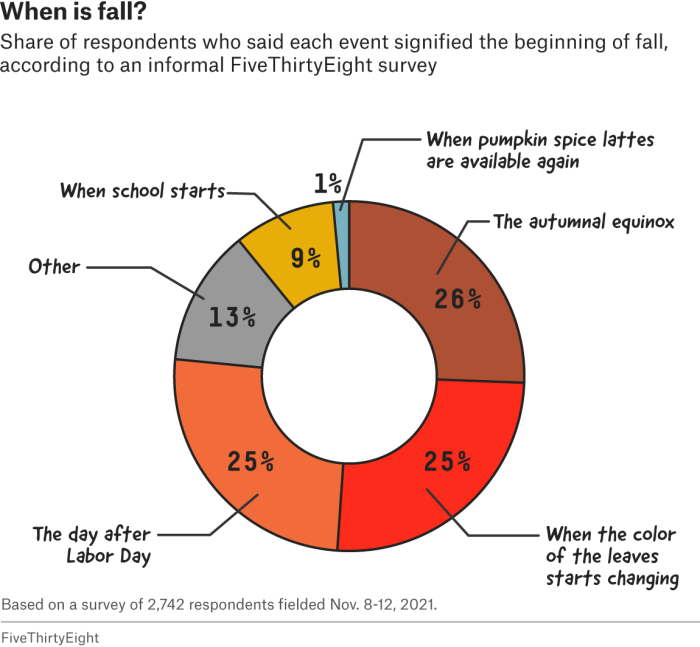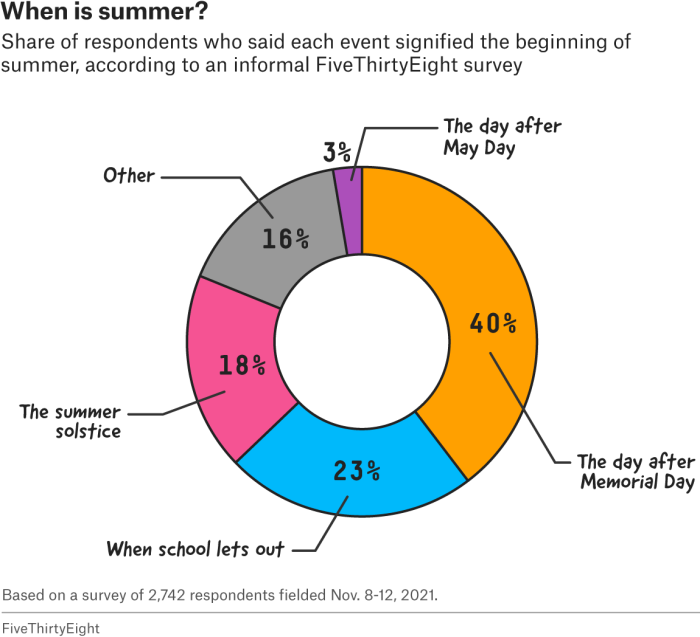While the emotional toll of the pandemic may have completely wrecked our perception of time, periodic glances out our windows plus our knowledge of orbital dynamics confirm that Earth is continuing its annual revolution around our closest star. So even if we lose track of days or weeks, we can at least observe nature’s cycles and find comfort in the changing seasons together.
Or we could if we were able to stop arguing long enough to come to an agreement on when each season actually starts.
FiveThirtyEight conducted an informal poll (i.e., a Google form) to find out what people think marks the seasons. By the end of the four-day survey, 2,742 readers had shared their thoughts.
Readers were asked to select from a list of options to indicate when each season begins. Overall, they were more open to considering qualitative metrics for determining the start of the transitional seasons, fall and spring, than of winter or summer.
Here’s how the reader-generated calendar of the seasons breaks down.
Take a look and perhaps you’ll find something other than politics to argue about with your family this Thanksgiving — truly something to be thankful for.
A plurality of respondents (37 percent) said spring begins when buds appear on the trees, while 33 percent said it starts on the spring or vernal equinox, which falls on or around Mar. 20 in the Northern Hemisphere.

For fall, 26 percent said the season begins on the autumnal equinox, which lands on or around Sept. 22 in the Northern Hemisphere. But 25 percent said fall starts when the leaves start to change color. Another 25 percent said fall begins the day after Labor Day, which is obviously incorrect.

For summer, 40 percent of respondents — the largest plurality we had for any season — said the season begins the day after Memorial Day (in 2021, that was June 1). Twenty-three percent said summer starts when school lets out, and 18 percent said it begins on the summer solstice, which is on or around June 20 in the Northern Hemisphere.

And in case you had any doubt that America is first and foremost a capitalist society, the most popular response for when winter begins was Black Friday, with 23 percent selecting that option. (Of course, it is also the day after Thanksgiving, which could be seen as the pinnacle of harvest festivities.)
Twenty-one percent said winter starts on the winter solstice (on or around Dec. 21 in the Northern Hemisphere), while 12 percent said it was when the first snow falls — the same percentage who said winter starts when the first snow sticks to the ground.

Readers were also asked whether they associated the start of a season with a specific date rather than with a phenomenon (like leaves changing colors) or a moving holiday (like Black Friday) and, if so, to mark it on a calendar. FiveThirtyEight got a wide range of dates, but a plurality (or, in the case of summer and winter, a majority) of respondents landed on the first day of a month near the start of that season. For spring, 25 percent said it begins on March 1, while 51 percent said summer starts on June 1.
Sept. 1 got the most votes for fall, with 31 percent, and Dec. 1 was deemed the start of winter by 51 percent of our survey-takers. These dates correlate with the meteorological seasons, which are based on the annual temperature cycle, not the astronomical seasons (think the solstices and equinoxes), which are based on Earth’s tilt and the sun’s alignment over the equator.
According to David Macauley, a philosophy and environmental studies professor at Penn State University and editor of “The Seasons: Philosophical, Literary and Environmental Perspectives,” the fact that there were both a variety in responses and a fair amount of consensus around particular dates or markers shows how deeply imbued the traditional notions of the seasons are in the American psyche, even with all our regional and cultural differences.
Historically, said Macauley, the seasons were closely tied to our agricultural cycle: Spring was for planting, summer was for growing, fall was for harvesting, and in winter we lived off the stores. But, over time, as we moved away from a largely agrarian society, those practical associations with the changing seasons were overtaken by cultural signifiers. “The astronomical stuff got connected with the cultural stuff — Halloween, Easter, basically everything Norman Rockwell and others popularized in American culture. And that became part of our national identity,” he said.
In addition to multiple-choice options for when each season begins, FiveThirtyEight allowed respondents to write their own answers. Some of these responses were very specific. For example, one reader wrote that spring begins when their “malamute/husky begins to shed her heavy winter undercoat.” Another wrote that they know it’s summer “when the urge to grill and barbecue becomes too much.”
These open-ended responses revealed how big an influence religious and cultural calendars have on many people’s views of the seasons. Readers shared religious or cultural dates that help them mark the changing of the seasons. Eight readers said they considered it winter on the first day of Advent, the Christian liturgical season leading up to Christmas. Two readers marked the start of winter with Samhain, an ancient Celtic pagan festival signaling the end of harvest season. One reader said they measured the beginning of summer and winter by the Chinese solar terms of lì xià and lì dōng, respectively.
Another major cultural influence that measures the seasons: sports. Multiple respondents marked the start of spring with the first day of spring training for Major League Baseball or with opening day. Others thought opening day heralded the start of summer. Four respondents said March Madness signaled the start of spring for them. Some marked the beginning of fall by the start of the MLB playoffs or when football season (both college and professional or, in one instance, pee-wee) begins. One fan noted that winter begins “when the Steelers are out of the playoffs.”
Other responses reveal regional differences in seasonal perception. Considering that most of the U.S. doesn’t experience the prototypical New England-style four seasons, it’s understandable that gauging the seasons would look different depending on where you live. Using ZIP codes readers provided, they found that in the area around Phoenix, summer starts when there are “multiple 100-plus [degrees Fahrenheit] days in a row,” while in Tampa, Florida, summer equals hurricane season; in the Pacific Northwest, it’s when it stops raining all the time. And you get one guess where the reader who gave these responses lives: Winter starts with “the first five-car pileup on the pike due to ice.” Spring comes when “the snow pile melts at the mall.” Summer is marked by “Red Sox opening day,” which was April 1 this year. And it’s only fall once “Sam Adams OctoberFest is on the shelves.”


